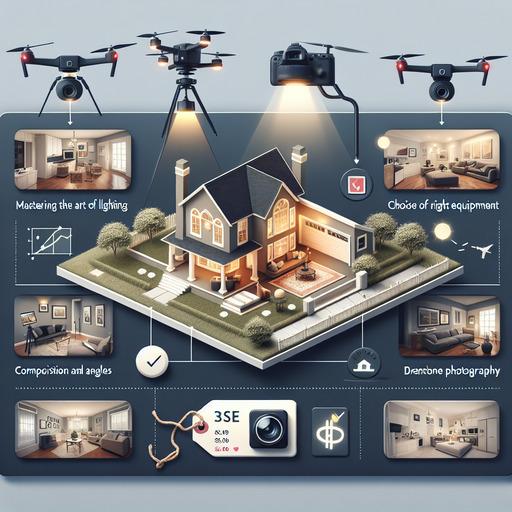
-
Table of Contents
- Mastering Real Estate Photography: Tips, Techniques, and Tools
- Understanding the Importance of Real Estate Photography
- Essential Real Estate Photography Tips
- 1. Mastering the Art of Lighting
- 2. Choosing the Right Equipment
- 3. Composition and Angles
- Enhancing Photos with Real Estate Photography Editing
- Exploring Real Estate Drone Photography
- Real Estate Photography Pricing: What to Consider
- Conclusion
- Questions and Answers
Mastering Real Estate Photography: Tips, Techniques, and Tools
In the competitive world of real estate, first impressions are everything. High-quality real estate photography can make or break a property listing, influencing potential buyers’ decisions before they even step foot inside. Whether you’re a seasoned photographer or a real estate agent looking to enhance your listings, understanding the nuances of real estate photography is crucial. This guide will walk you through essential tips, techniques, and tools to elevate your property photography game.
Understanding the Importance of Real Estate Photography
Real estate photography is more than just snapping pictures of a property. It’s about capturing the essence and potential of a space, enticing potential buyers to envision themselves living there. According to the National Association of Realtors, 87% of home buyers found photos to be the most useful feature when searching for a home online. This statistic underscores the importance of investing in quality photography to make your listings stand out.
Essential Real Estate Photography Tips
1. Mastering the Art of Lighting
Lighting is a critical component of real estate photography. Proper lighting can highlight a property’s best features and create a warm, inviting atmosphere.
- Natural Light: Whenever possible, schedule shoots during the day to take advantage of natural light. Open curtains and blinds to let in as much light as possible.
- Artificial Lighting: Use additional lighting equipment, such as softboxes or LED panels, to fill in shadows and create a balanced look.
2. Choosing the Right Equipment
Investing in the right equipment can significantly impact the quality of your real estate photos.
- Camera: A DSLR or mirrorless camera with a wide-angle lens is ideal for capturing expansive interior shots.
- Tripod: A sturdy tripod ensures stability and allows for longer exposure times, which is essential in low-light conditions.
3. Composition and Angles
Composition plays a vital role in real estate photography. The right angles can make rooms appear larger and more inviting.
- Wide Shots: Use wide-angle lenses to capture the full scope of a room.
- Height: Shoot from a height of about 5 feet to provide a natural perspective.
Enhancing Photos with Real Estate Photography Editing
Editing is where good photos become great. Post-processing can correct lighting issues, enhance colors, and remove distractions.
- Software: Use editing software like Adobe Lightroom or Photoshop to adjust brightness, contrast, and saturation.
- Consistency: Maintain a consistent editing style across all photos to create a cohesive look for your listings.
Exploring Real Estate Drone Photography
Drone photography offers a unique perspective, showcasing properties from above and highlighting their surroundings.
- Regulations: Ensure you comply with local regulations and obtain necessary permits for drone use.
- Angles: Capture aerial shots that highlight the property’s location, size, and nearby amenities.
Real Estate Photography Pricing: What to Consider
Pricing your real estate photography services can be challenging. Consider factors such as the size of the property, the number of photos required, and any additional services like drone photography or virtual tours.
- Market Rates: Research local market rates to ensure your pricing is competitive.
- Value: Highlight the value you bring, such as high-quality images and quick turnaround times.
Conclusion
Real estate photography is a powerful tool in the property market, capable of transforming listings and attracting potential buyers. By mastering lighting, composition, and editing, and by utilizing the right equipment and techniques, you can create stunning images that showcase properties in their best light. Whether you’re a photographer or a real estate professional, these insights will help you elevate your real estate photography game.
For more information on real estate photography, check out this Wikipedia page on real estate photography.
Questions and Answers
Q1: What is the best time of day for real estate photography?
A1: The best time for real estate photography is during the day when natural light is abundant. Early morning or late afternoon provides soft, diffused light that enhances the property’s features.
Q2: How can I make small rooms appear larger in photos?
A2: Use a wide-angle lens to capture more of the room in a single shot. Shooting from a corner and keeping the camera at a height of about 5 feet can also help create the illusion of space.
Q3: Is drone photography necessary for all real estate listings?
A3: Drone photography is not necessary for all listings but can be beneficial for properties with large outdoor spaces or unique locations. It provides a comprehensive view of the property and its surroundings.
If you’re interested in learning more about our real estate photography services or have any questions, please contact us.